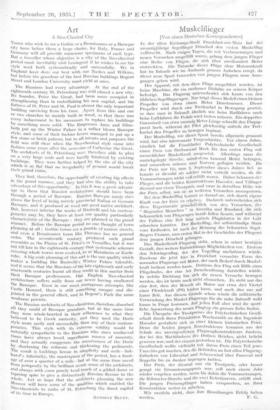Art
A Neo-Classical City THOSE who wish to see a Gothic or a Renaissance or a Baroque city have before them a large choice, for Italy, France and Germany will all provide numerous specimens of each type. But a traveller whose objective is a city of the Neo-classical Period must inevitably visit Leningrad if he wishes to see the style Used both systematically and successfully. We in England have done our best with our Nashes and Wilkins, but before the grandeur of the best Russian buildings Regent Street and London University must yield at once.
The Russians had every advantage. At the end of the eighteenth century St. Petersburg was still almost a new city. Its founder, Peter the Great, had been more occupied in strengthening than in embellishing his new capital, and the fortress of St. Peter and St. Paul is almost the only important building surviving from his time. Apart from this and one • or two churches he mainly built in wood, so that there was every inducement to his successors to replace his buildings by something more solid. The Erapresses Anne and Eliza- beth put up the Winter Palace in a rather blown Baroque Style, and some of their luckier lovers managed to put up a few stone or brick palaces, but to all intents and purposes the field was still clear when the Neo-classical style came into fashion some years after the accession of Catherine the Great. The architects of St. Petergburg were therefore able to plan on a very large scale and were hardly hindered site existing buildings. They were further helped by the site of the city which is so flat that no irregularity of ground would break their grand vistas. • . They had, therefore, the ,opportunity of creating big effects in the grand manner,. and they had also the ability to take advantage of this opportunity; In this it was a great advant- age to them that Russian architecture should have been through a period of Baroque. ' Russian Baroque rarely rises above the level of being merely provincial Italian or German Baroque, and it produced at most one good native architect. But, howeVer inferior the warks of Rastrelli and, his content- lioraries may, be,, they have at least one quality particularly characteristic of the Baroque : they are planned in the grand manner.' Before the BaroqUe period no one thought of town planning at all ; Gothic towns are u jumble of narrow streets, and pyen a Renaissance town like general Florence. has no order, The seventeenth century produced such grand ensembles as the ,Piazza of St. Peter'sbut it was or Versailles, riot till late in the eighteenth century that systematic schemes eoVering whole towns were evolved, as at Mannheim or Karls- ruhe,A big scale planning of this sort is the one quality which niakes a building like Rastrelli's ' Winter Palace tolerable, and it seems that the Russians of the late eighteenth and early nineteenth centuries learnt all they could in this matter front their Baroque predecessors. OarEnglish Neo-classical architecture, suffers sadly from our. never having swallowed the Baroque. Even in our most, courageous attempts, like Castle' Howard, there is still something , meagre and dis- jointed in the general effect, and in Regent's Park the same Weakness persists. • . The Russian architects of Neo-classicism, therefore, absorbed all they could of Baroque grandeur, but at the same time they were whole-hearted in their adherence to what they believed to be Greek austerity, and they used the Doric: style more easily and successfully than any of their contem- poraries. This style with its extreme solidity would be naturally sympathetic to the Russians who since mediaeval times hdve always loved.. superfluous masses of masonry, and they actually. exaggerate the massiveness of the Doric t'37- shortening the columns and thickening the pediments. The result is buildings heroic in simplicity and.. scale—Sak- harof's Admiralty, the masterpiece of the period, has a front- age of over a quarter of a mile---but at the same time saved from pomposity. by the brilliant scenic sense of the architects, and always with some purely local touch of a gilded dome or tapering spire to give a distinctively Russian, •flavour to the Whole. ..Let us hope that the architects planning the new Moscow will have some of the, qualities which 'enabled the Neo-classicists to make of St. Petersburg the finest capital of its time in Europe.
ANTIIONY BLUNT.






































 Previous page
Previous page